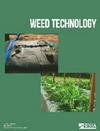大豆杂草防治关键时期覆盖和保护性耕作对杂草的影响
IF 1.7
3区 农林科学
Q3 AGRONOMY
引用次数: 0
摘要
有限的研究直接针对评估单一覆盖作物种植在最初的田间季节之后抑制作物杂草的能力。因此,本试验旨在研究大豆第二年自愈一年生和第二年多年生覆盖作物在杂草防治关键期(CPWC)对杂草的抑制能力。整块处理包括:(1)常规耕作,(2)覆盖作物残茬免耕,(3)活膜+覆盖作物残茬,(4)活膜+冬杀残。分小区处理涉及杂草管理强度:a)无杂草管理(杂草丛生),b)通过CPWC(大豆第三节期)人工清除杂草;V3)和c)人工清除杂草,直到大豆冠层闭合(无杂草)。总体而言,第二个田间季节的年覆盖作物总生物量与第一个田间季节直接播种林分获得的生物量相当。与传统耕作相比,所有覆盖作物处理通过CPWC减少了杂草总生物量。本试验各处理大豆产量均较低。在一个立地年,覆盖作物和常规耕作处理的产量相近,但在另一个立地年,所有覆盖作物处理的产量都较低。本文章由计算机程序翻译,如有差异,请以英文原文为准。
Influence of cover cropping and conservation tillage on weeds during the critical period for weed control in soybean
Abstract Limited research has been directed at evaluating the ability of single cover crop plantings to suppress weeds in crops beyond the initial field season. Thus, this experiment was conducted to investigate the ability of a second-year self-regenerated annual and second-year perennial cover crop planting to suppress weeds during the critical period for weed control (CPWC) in soybean. Whole plot treatments included: (1) conventional till, (2) no-till with cover crop residue, (3) living mulch + cover crop residue, and (4) living mulch + winter killed residue. Sub-plot treatments involved weed management intensity: a) no weed management (weedy), b) weeds manually removed through the CPWC (third node soybean stage; V3), and c) weeds manually removed until soybean canopy closure (weed-free). Overall, total annual cover crop biomass during the second field season was comparable to biomass obtained from direct seeded stands during the initial field season. All cover crop treatments reduced total weed biomass through the CPWC compared to conventional till. Soybean yield was low across all treatments in this experiment. Still, yield was similar between cover crop and conventional till treatments at one site-year, however, yields were lower in all cover crop treatments at the other site-year.
求助全文
通过发布文献求助,成功后即可免费获取论文全文。
去求助
来源期刊

Weed Technology
农林科学-农艺学
CiteScore
2.90
自引率
21.40%
发文量
89
审稿时长
12-24 weeks
期刊介绍:
Weed Technology publishes original research and scholarship in the form of peer-reviewed articles focused on understanding how weeds are managed.
The journal focuses on:
- Applied aspects concerning the management of weeds in agricultural systems
- Herbicides used to manage undesired vegetation, weed biology and control
- Weed/crop management systems
- Reports of new weed problems
-New technologies for weed management and special articles emphasizing technology transfer to improve weed control
-Articles dealing with plant growth regulators and management of undesired plant growth may also be accepted, provided there is clear relevance to weed science technology, e.g., turfgrass or woody plant management along rights-of-way, vegetation management in forest, aquatic, or other non-crop situations.
-Surveys, education, and extension topics related to weeds will also be considered
 求助内容:
求助内容: 应助结果提醒方式:
应助结果提醒方式:


